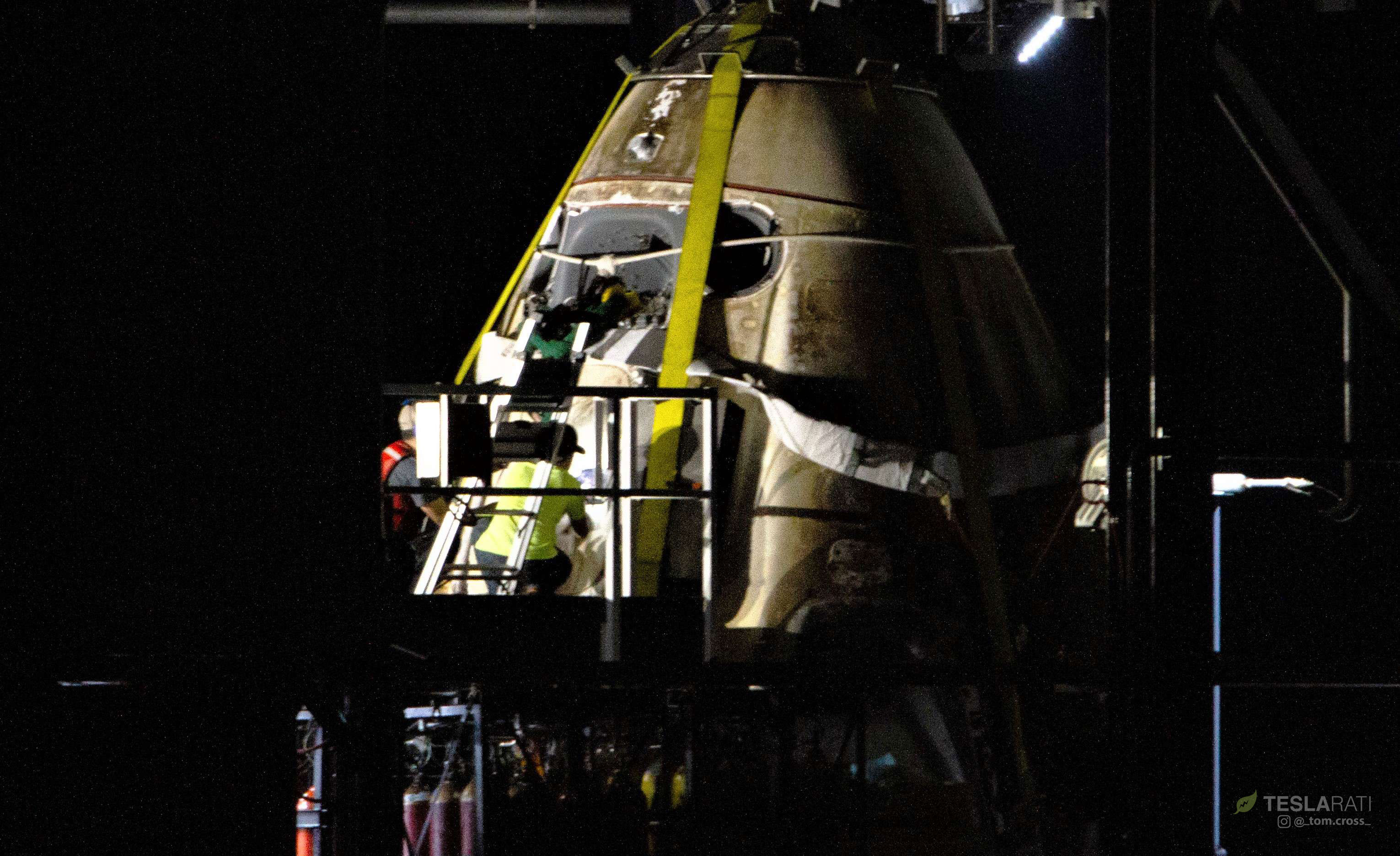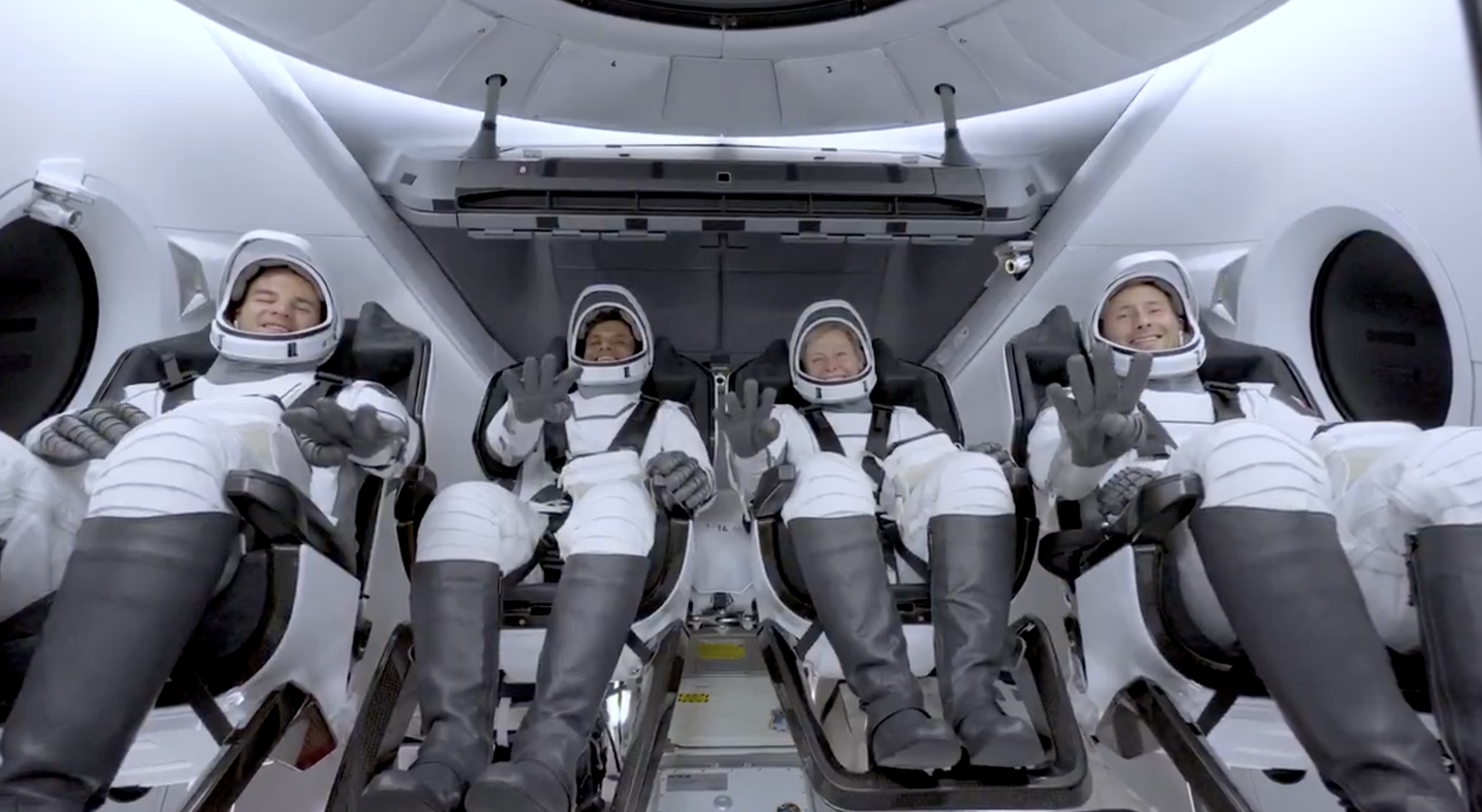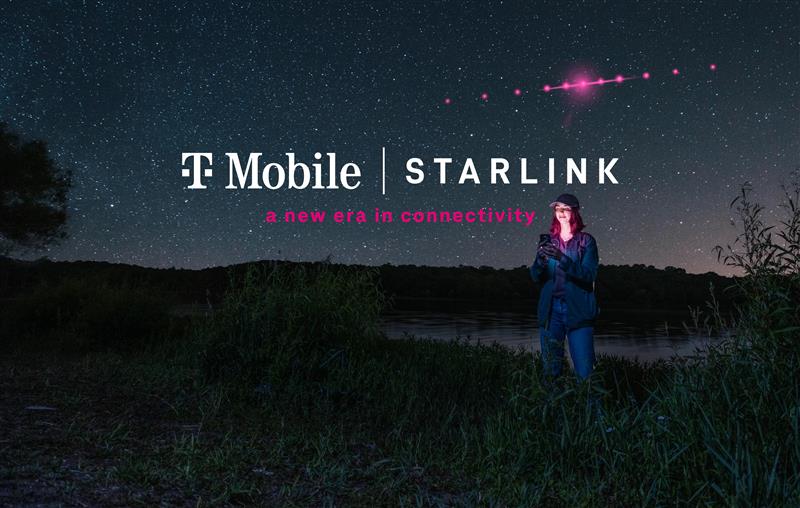

SpaceX
SpaceX’s Crew Dragon returns to port as NASA praises successful launch debut
SpaceX’s Crew Dragon spacecraft successfully returned to Port Canaveral aboard recovery vessel GO
The culmination of the better part of a decade of constant work and NASA support, the flawless success of SpaceX’s DM-1 Crew Dragon mission is a testament – above all else – to the many hundreds of thousands or millions of hours SpaceX employees have put into the spacecraft’s design, production, operation, and recovery. While just one half of a critical pair of demonstrations, DM-1’s success should translate into extremely good odds for Crew Dragon’s Demo Mission 2 (DM-2), in which SpaceX will launch two NASA astronauts to the International Space Station on the company’s first crewed launch ever.
“I can’t believe how well the whole mission has gone. I think on every point, everything’s been nailed, all the way along—particularly this last piece. We were all very excited to see re-entry and parachute and drogue deploy and main deploy, splashdown—everything happened just perfectly, right on time the way that we expected it to. It was beautiful.” – Benji Reed, Director of Crew Mission Management, SpaceX
SpaceX Director of Crew Mission Management Benji Reed’s unqualified appraisal of Crew Dragon’s debut serves as a perfect example of the attitude almost universal throughout the company in the twilight of the mission’s completion. While sources suggest that there were more than a few hiccups during the mission, they were extremely mild and came as no surprise for what effectively amounted to the first shakeout mission of a brand new vehicle. According to CEO Elon Musk, Crew Dragon shares almost no hardware – aside from its Draco thrusters – with Cargo Dragon, the uncrewed orbital spacecraft SpaceX has now launched into orbit 17 times in the last eight years.

Crew Dragon approaches the ISS during its orbital launch debut, March 3rd. (NASA) 
Cargo Dragon is seen here attached to the ISS shortly before the completion of SpaceX’s CRS-16 resupply mission, January 7th. (NASA) 
Crew Dragon was successfully recovered aboard GO Searcher on March 8th. (SpaceX) 
Cargo Dragon completed its most recent mission, CRS-16, on January 13th. (SpaceX)
For such a complex spacecraft, not to mention an almost clean-sheet redesign, it’s nothing short of extraordinary that its debut launch was so utterly free of significant anomalies or unexpected behavior. Separated into the distinct phases of launch, free-flight, ISS docking/undocking, and recovery, Crew Dragon reportedly performed almost perfectly in all cases, “right on time” according to Mr. Reed. NASA’s CCP Deputy Manager Steve Stich was equally enthusiastic and elated about the spacecraft’s performance.
“On-orbit we got a lot of great data on the vehicle in terms of the thermal performance and power performance; the vehicle really did better than we expected. Then the rendezvous was phenomenal as we came in and checked out those sensors. Today; the undocking, watching how those systems performed, that went flawlessly. It’s a very tight sequence between undocking and de-orbit burn, how the nose cone performed, how the de-orbit burn was executed, then the entry was phenomenal.”
“I don’t think we saw really anything in the mission so far—and we’ve got to do to the data reviews—that would preclude us from having the crewed mission [DM-2] later this year.”
– Steve Stich, CCP Deputy Manager, NASA
Following Crew Dragon’s March 9/10 return to Port Canaveral, the spacecraft is expected to immediately enter into a post-flight analysis and data-gathering phase that will quickly transfer into refurbishment to prepare for the capsule’s second (albeit suborbital) launch, a critical in-flight abort (IFA) test that could happen as early as April according to Elon Musk. While official planning schedules point towards the IFA occurring closer to June or even July, it’s reasonable to assume that those official schedules are highly conservative. If Crew Dragon’s significantly waterproofing and reusability upgrades make a major difference, it’s far from inconceivable that the vehicle’s second abort test could actually occur ahead of schedule, although it’s unlikely.
The in-flight abort test will effectively be a repeat of SpaceX’s successful 2015 pad abort demonstration, albeit with the stationary launch pad replaced with a full Falcon 9 rocket – first and second stage – traveling at supersonic speeds. If Crew Dragon can safely abort in such challenging conditions, it’s almost guaranteed that it will be able to safely abort at any time during a Falcon 9 launch, all the way from the moment fueling begins on the ground into orbital operations. In fact, CEO Elon Musk recently suggested that the same SuperDraco abort thrusters that enable those safe escapes could potentially be used to add yet another level of redundancy during landing, standing in for parachute damage or failures to slow the capsule down and minimize or prevent injuries during splashdown.
Check out Teslarati’s Marketplace! We offer Tesla accessories, including for the Tesla Cybertruck and Tesla Model 3.
News
SpaceX’s Crew-11 mission targets July 31 launch amid tight ISS schedule
The flight will lift off from Launch Complex 39A at Kennedy Space Center in Florida.

NASA and SpaceX are targeting July 31 for the launch of Crew-11, the next crewed mission to the International Space Station (ISS). The flight will lift off from Launch Complex 39A at Kennedy Space Center in Florida, using the Crew Dragon Endeavour and a Falcon 9 booster.
Crew Dragon Endeavour returns
Crew-11 will be the sixth flight for Endeavour, making it SpaceX’s most experienced crew vehicle to date. According to SpaceX’s director of Dragon mission management, Sarah Walker, Endeavour has already carried 18 astronauts representing eight countries since its first mission with NASA’s Bob Behnken and Doug Hurley in 2020, as noted in an MSN report.
“This Dragon spacecraft has successfully flown 18 crew members representing eight countries to space already, starting with (NASA astronauts) Bob (Behnken) and Doug (Hurley) in 2020, when it returned human spaceflight capabilities to the United States for the first time since the shuttle retired in July of 2011,” Walker said.
For this mission, Endeavour will debut SpaceX’s upgraded drogue 3.1 parachutes, designed to further enhance reentry safety. The parachutes are part of SpaceX’s ongoing improvements to its human-rated spacecraft, and Crew-11 will serve as their first operational test.
The Falcon 9 booster supporting this launch is core B1094, which has launched in two previous Starlink missions, as well as the private Ax-4 mission on June 25, as noted in a Space.com report.
The four-members of Crew-11 are NASA astronauts Zena Cardman and Mike Fincke, as well as Japan’s Kimiya Yui and Russia’s Oleg Platonov.
Tight launch timing
Crew-11 is slated to arrive at the ISS just as NASA coordinates a sequence of missions, including the departure of Crew-10 and the arrival of SpaceX’s CRS-33 mission. NASA’s Bill Spetch emphasized the need for careful planning amid limited launch resources, noting the importance of maintaining station altitude and resupply cadence.
“Providing multiple methods for us to maintain the station altitude is critically important as we continue to operate and get the most use out of our limited launch resources that we do have. We’re really looking forward to demonstrating that capability with (CRS-33) showing up after we get through the Crew-11 and Crew-10 handover,” Spetch stated.
News
SpaceX launches Ax-4 mission to the ISS with international crew
The SpaceX Falcon 9 launched Axiom’s Ax-4 mission to ISS. Ax-4 crew will conduct 60+ science experiments during a 14-day stay on the ISS.

SpaceX launched the Falcon 9 rocket kickstarting Axiom Space’s Ax-4 mission to the International Space Station (ISS). Axiom’s Ax-4 mission is led by a historic international crew and lifted off from Kennedy Space Center’s Launch Complex 39A at 2:31 a.m. ET on June 25, 2025.
The Ax-4 crew is set to dock with the ISS around 7 a.m. ET on Thursday, June 26, 2025. Axiom Space, a Houston-based commercial space company, coordinated the mission with SpaceX for transportation and NASA for ISS access, with support from the European Space Agency and the astronauts’ governments.
The Ax-4 mission marks a milestone in global space collaboration. The Ax-4 crew, commanded by U.S. astronaut Peggy Whitson, includes Shubhanshu Shukla from India as the pilot, alongside mission specialists Sławosz Uznański-Wiśniewski from Poland and Tibor Kapu from Hungary.
“The trip marks the return to human spaceflight for those countries — their first government-sponsored flights in more than 40 years,” Axiom noted.
Shukla’s participation aligns with India’s Gaganyaan program planned for 2027. He is the first Indian astronaut to visit the ISS since Rakesh Sharma in 1984.
Axiom’s Ax-4 mission marks SpaceX’s 18th human spaceflight. The mission employs a Crew Dragon capsule atop a Falcon 9 rocket, designed with a launch escape system and “two-fault tolerant” for enhanced safety. The Axiom mission faced a few delays due to weather, a Falcon 9 leak, and an ISS Zvezda module leak investigation by NASA and Roscosmos before the recent successful launch.
As the crew prepares to execute its scientific objectives, SpaceX’s Ax-4 mission paves the way for a new era of inclusive space research, inspiring future generations and solidifying collaborative ties in the cosmos. During the Ax-4 crew’s 14-day stay in the ISS, the astronauts will conduct nearly 60 experiments.
“We’ll be conducting research that spans biology, material, and physical sciences as well as technology demonstrations,” said Whitson. “We’ll also be engaging with students around the world, sharing our experience and inspiring the next generation of explorers.”
SpaceX’s Ax-4 mission highlights Axiom’s role in advancing commercial spaceflight and fostering international partnerships. The mission strengthens global space exploration efforts by enabling historic spaceflight returns for India, Poland, and Hungary.
News
Starlink Cellular’s T-Mobile service to grow with third-party app data
From Oct 2025, T-Satellite will enable third-party apps in dead zones! WhatsApp, X, AccuWeather + more coming soon.

Starlink Cellular’s T-Mobile service will expand with third-party app data support starting in October, enhancing connectivity in cellular dead zones.
T-Mobile’s T-Satellite, supported by Starlink, launches officially on July 23. Following its launch, T-Mobile’s Starlink Cellular service will enable data access for third-party apps like WhatsApp, X, Google, Apple, AccuWeather, and AllTrails on October 1, 2025.
T-Mobile’s Starlink Cellular is currently in free beta. T-Satellite will add MMS support for Android phones on July 23, with iPhone support to follow. MMS support allows users to send images and audio clips alongside texts. By October, T-Mobile will extend emergency texting to all mobile users with compatible phones, beyond just T-Mobile customers, building on its existing 911 texting capability. The carrier also provides developer tools to help app makers integrate their software with T-Satellite’s data service, with plans to grow the supported app list.
T-Mobile announced these updates during an event celebrating an Ookla award naming it the best U.S. phone network, a remarkable turnaround from its last-place ranking a decade ago.
“We not only dream about going from worst to best, we actually do it. We’re a good two years ahead of Verizon and AT&T, and I believe that lead is going to grow,” said T-Mobile’s Chief Operating Officer Srini Gopalan.
T-Mobile unveiled two promotions for its Starlink Cellular services to attract new subscribers. A free DoorDash DashPass membership, valued at $10/month, will be included with popular plans like Experience Beyond and Experience More, offering reduced delivery and service fees. Meanwhile, the Easy Upgrade promotion targets Verizon customers by paying off their phone balances and providing flagship devices like the iPhone 16, Galaxy S25, or Pixel 9.
T-Mobile’s collaboration with SpaceX’s Starlink Cellular leverages orbiting satellites to deliver connectivity where traditional networks fail, particularly in remote areas. Supporting third-party apps underscores T-Mobile’s commitment to enhancing user experiences through innovative partnerships. As T-Satellite’s capabilities grow, including broader app integration and emergency access, T-Mobile is poised to strengthen its lead in the U.S. wireless market.
By combining Starlink’s satellite technology with strategic promotions, T-Mobile is redefining mobile connectivity. The upcoming third-party app data support and official T-Satellite launch mark a significant step toward seamless communication, positioning T-Mobile as a trailblazer in next-generation wireless services.
-

 Elon Musk2 weeks ago
Elon Musk2 weeks agoTesla investors will be shocked by Jim Cramer’s latest assessment
-

 News2 days ago
News2 days agoTesla debuts hands-free Grok AI with update 2025.26: What you need to know
-

 Elon Musk4 days ago
Elon Musk4 days agoxAI launches Grok 4 with new $300/month SuperGrok Heavy subscription
-

 Elon Musk6 days ago
Elon Musk6 days agoElon Musk confirms Grok 4 launch on July 9 with livestream event
-

 News1 week ago
News1 week agoTesla Model 3 ranks as the safest new car in Europe for 2025, per Euro NCAP tests
-

 Elon Musk2 weeks ago
Elon Musk2 weeks agoxAI’s Memphis data center receives air permit despite community criticism
-

 News4 days ago
News4 days agoTesla begins Robotaxi certification push in Arizona: report
-

 Elon Musk2 weeks ago
Elon Musk2 weeks agoTesla scrambles after Musk sidekick exit, CEO takes over sales

















